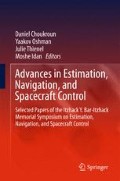Abstract
Navigation plays a major role in space missions. For a cislunar space mission, such as Chandrayaan-2, deep space radar, inertial navigation system and optical navigation system are used to determine the position and velocity of the spacecraft.
In the present work, a mathematical model of Chandrayaan-2 motion is developed which includes J2 effect of the Earth and the Moon, solar gravitational perturbation and solar radiation pressure. Based on this model a nominal lunar transfer trajectory is simulated. Models for ground-based measurements (azimuth, elevation, range and range rate) are described. Time delays due to finite speed of electromagnetic waves are considered in the measurement. Effects of tropospheric and ionospheric refraction on measurements are incorporated in the simulation. Tropospheric errors are corrected using Saastamoinen zenith range correction model and ionospheric range errors are corrected using dual-frequency measurements. MATLAB codes are developed to simulate the observations from four ground station facilities, viz. Indian Deep Space Network, (IDSN) Byalalu, Karnataka, India as well as Deep Space Communication Complex, Goldstone, California, USA, Deep Space Communication Complex, Madrid, Spain and Deep Space Communication Complex, Canberra, Australia.
The polar measurements are used in Extended Kalman Filter (EKF) algorithm to estimate position and velocity of Chandrayaan-2 in the inertial Cartesian frame. To compensate for the time delay in measurements, the states are propagated till the time corresponding to the delayed measurements and then updated. These updated states are then propagated further till the current time to obtain the current estimates. This technique results in 11.79 km of range uncertainty (1σ) and 6.93 m/s of speed uncertainty (1σ) at the time of arrival at the insertion point to the lunar parking orbit of Chandrayaan-2.
Access this chapter
Tax calculation will be finalised at checkout
Purchases are for personal use only
Preview
Unable to display preview. Download preview PDF.
References
Battin, R.H.: An Introduction to the Mathematics and Methods of Astrodynamics. AIAA (1987)
D’Souza, C., Crain, T., Clark, F.D., Getchius, J.: Orion cislunar guidance guidance and navigation. In: AIAA Guidance, Navigation and Control Conference and Exhibit (2007)
Grewal, M.S., Weill, L.R., Andrews, A.P.: Global Positioning Systems, Inertial Navigation, and Integration. John Wiley & Sons, Inc. (2007)
Kruger, B.: The range rate error due to the averaging techniques of doppler measurements. Tech. rep., Goddard Space Flight Center (1965)
Montenbruck, O., Gill, E.: Satellite Orbits Models, Methods, and Applications. Springer (2000)
Muñoz, S., Christian, J.A., Lightsey, E.G.: Development of an end to end simulation tool for autonomous cislunar navigation. In: Navigation, and Control Conference. AIAA (2009)
Roncoli, R.B.: Lunar constants ans models document. Tech. rep., Jet Propulsion Laboratory (2005)
Vighnesam, N.V., Sonney, A., Gopinath, N.S.: India’s first lunar mission chandrayaan-1 initial phase orbit determination. Acta Astronautica 67(4) (2010)
Vighnesam, N.V., Sonney, A., Subramaniam, B., Gopinath, N.S.: Precise orbit computation of india’s first lunar mission chandrayaan-1 using accelerometer and tracking data during early phase. In: 21st ISSFD (2009)
Author information
Authors and Affiliations
Corresponding author
Editor information
Editors and Affiliations
Rights and permissions
Copyright information
© 2015 Springer-Verlag Berlin Heidelberg
About this paper
Cite this paper
Biswas, S.K., Hablani, H.B. (2015). Ground Based Navigation of Spacecraft in Lunar Transfer Trajectory, with Application to Chandrayaan-2. In: Choukroun, D., Oshman, Y., Thienel, J., Idan, M. (eds) Advances in Estimation, Navigation, and Spacecraft Control. ENCS 2012. Springer, Berlin, Heidelberg. https://doi.org/10.1007/978-3-662-44785-7_20
Download citation
DOI: https://doi.org/10.1007/978-3-662-44785-7_20
Publisher Name: Springer, Berlin, Heidelberg
Print ISBN: 978-3-662-44784-0
Online ISBN: 978-3-662-44785-7
eBook Packages: EngineeringEngineering (R0)

